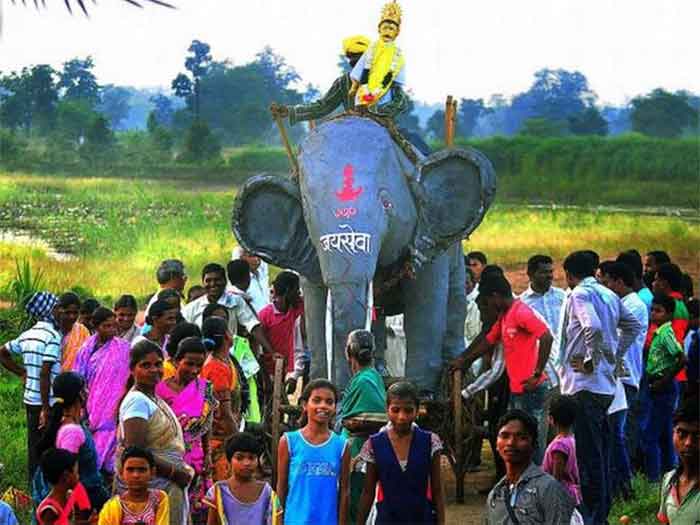
Why is Gondi – spoken by 2.7 million officially and 20 million unofficially – is not included in the Eighth Schedule? But Sanskrit not spoken in any part of India is included in the 8th Schedule?
Possibly because the former is a Black’s language and the latter a White’s one! Another important reason: Gonds venerate Ravan as their Raja, God and Dharmaguru.
All India Radio broadcasts news bulletin in Sanskrit, spoken by none. But no news bulletin in Gondi, spoken by millions.
There are 22 languages in the 8th schedule of the Indian Constitution.
Sanskrit is one of the 22 languages. At present, this language is not spoken in almost any part of India. But it is still spoken in Mattur (Mathur) village of Karnataka state.
Gondi is a tribal language. The total Gondi speaking population, according 2011 Census, is 27,13,790. But the Gond community leaders and observers say the actual numbers could be much higher, given the fact that huge concentrations of Gondi-speaking people are located in the Naxalite-affected areas of Madhya Pradesh, Maharashtra, Chhattisgarh, Odisha, Andhra Pradesh & Telangana; in most of these areas, no census is taking place.
Gondwana Ganatantra Party (GPP) president, Hira Singh Markam, says that based on surveys carried out by the party, the total number of people with Gondi as their first language is an estimated 20 million. “Since our surveys, too, have their limitations, the actual numbers could be well above this figure.”
“Quite a few of the Scheduled languages in India cannot boast of this big a number of speakers,” says Markam. “Yet govt has not included this language in the schedule.” Even the official figure of 2.7 million is higher than the number of speakers of languages like Dogri, Bodo and Manipuri, all of which have been included in the Schedule, rues Markam.
Gonds are believed to belong to the Dravidian stock. As the rest of the country burns effigies of Ravan, the ten-headed king is worshipped as god in a Gond village in Maharashtra.
Then in sync, everyone — men, women and children — bursts into a staccato of chanting, their arms flung into the air: ‘Jai Gondwana! Jai Seva! Jai Raja Ravan! Raja Ravanna Seva’!
According to Hindu beliefs, Ravan is synonymous with evil. Each year, a 10-headed effigy of the King of Lanka is symbolically slain on Dussehra.
But not in Paraswadi. This tiny village of less than 300 people, mostly the Gond tribals, is one among several villages scattered across Central India that provide a different narrative to the Ravan story. Here, Ravan is not the villain. He is venerated as a god, the dharmaguru of the tribe.
On October 13, Paraswadi was lost in gaiety, forgetting its miserable existence. It was the inaugural day of this year’s Ravan Mahotsav, an annual festival of the Gonds coinciding with the Hindu festival of Dussehra.
“Our understanding of Dussehra is different. It doesn’t signify the slaying of Ravan but implies ‘Dassar Puja’, or the worship of weapons,” says Vasudevrao Tekam, a descendant of the Gond king of Lanjhigarh in Odisha. Tekam was among the many Gond guests present at the function. “We have nothing to do with Hinduism. Gonds believe in totems. We are the warisdars of Ravan: Ravanvanshis. We are not Hindus. We are being forced to be Hindus…” Tekam’s disowning of Aryan terminologies is indicative of the Gonds’ counter-narrative.
According to their version, Ravan was a Gond king who was slain by Aryan invaders. He was the tenth dharmaguru of the tribe, carrying forward the legacy of Kupar Lingo, the supreme deity and heroic ancestor of Gonds, who gave them their phratry structures and lifestyle values.
In fact, their narration of Ravan’s story turns upside down the one in the Ramayan.
“Lanka does not refer to Sri Lanka but means a ‘hilly place’ in Gondi. Ravan was connected to Central India. In a clash of cultures, the Aryans distorted Gond history. Ravan dahan started only in 1838 in Nagpur. We have been worshipping Ravan for ages,” says Motiravan Kangale, a retired Reserve Bank of India official and Gondi scholar. Spurred by his opposition to the annual immolation of Ravan in his youth, Kangale had changed his name from Motiram to Motiravan.
In fact, Ravan has become a rallying point for the Gonds to counter the onslaught of Hinduism and saffronisation, led by the Rashtriya Swayamsevak Sangh, which has an extended outreach among the tribals. In July 1991, during the heyday of the Ram Janmabhoomi movement, gram panchayat teacher Maniravan Duga, 53, quit his job and dedicated his time to set up the Gondwana Gond Sanskruti Bachao Samiti. The small organisation has, for the past 24 years, organised Ravan Mahotsav in the region, to promote and preserve Gond culture.
“There’s a lot being said about Ravan. Brahmins claim he was one of them. But no Brahmin ever says that he is a Ravanvanshi. We Gonds are proud to say we are Ravanvanshis,” says Duga.
In the 1980s and the 1990s, among the grass roots workers engaged with the Gonds was Vira Sathidar, the Dalit activist known best for his lead role in the film Court, India’s official entry to the Oscars for 2016. In October 1989, when the Ram Janmabhoomi movement was gaining momentum, Sathidar participated in a ‘Ravan Vijay’ rally in Nagpur, to counter the annual Vijaya Dashami rally of the RSS. However, Sathidar and others were attacked by Hindutva activists.
The Gonds believe their ‘cultural destruction’ has been expedited with the outreach of saffron forces into tribal realms. The Gonds, however, see Ekal Vidyalayas as an assault on their cultural values; a conspiracy to Hinduise them.
Sandwiched between the Maoists and the Hindutva forces, symbolises the quandary of the Gonds. In Ravan, they are searching for a totem to mobilise their cultural cohesion.
Sankara Narayanan is a political commentator Mail: [email protected]
Reference: ‘Celebrating Ravan’ by Omar Rashid, The Hindu/ Oct 24, 2015.
SIGN UP FOR COUNTERCURRENTS DAILY NEWSLETTER













































